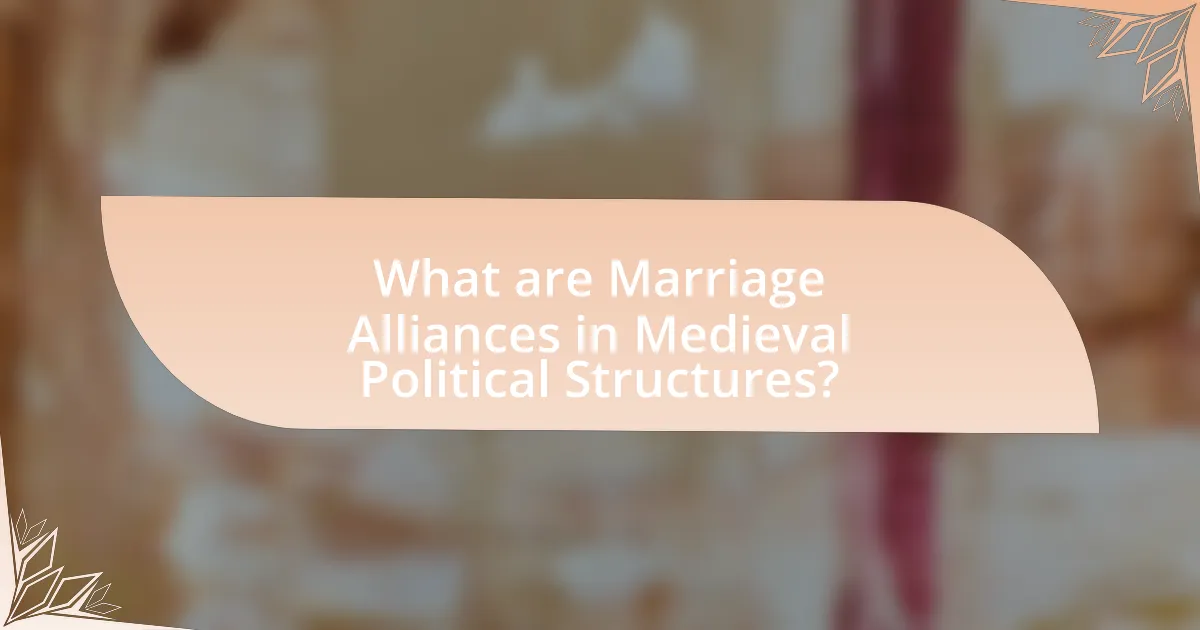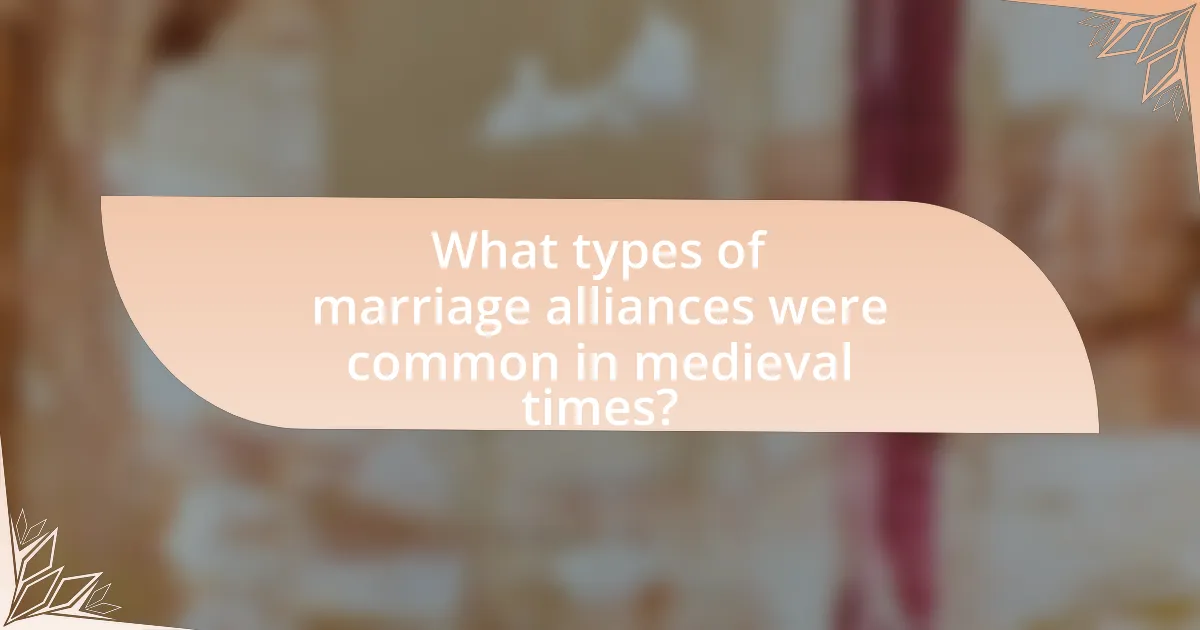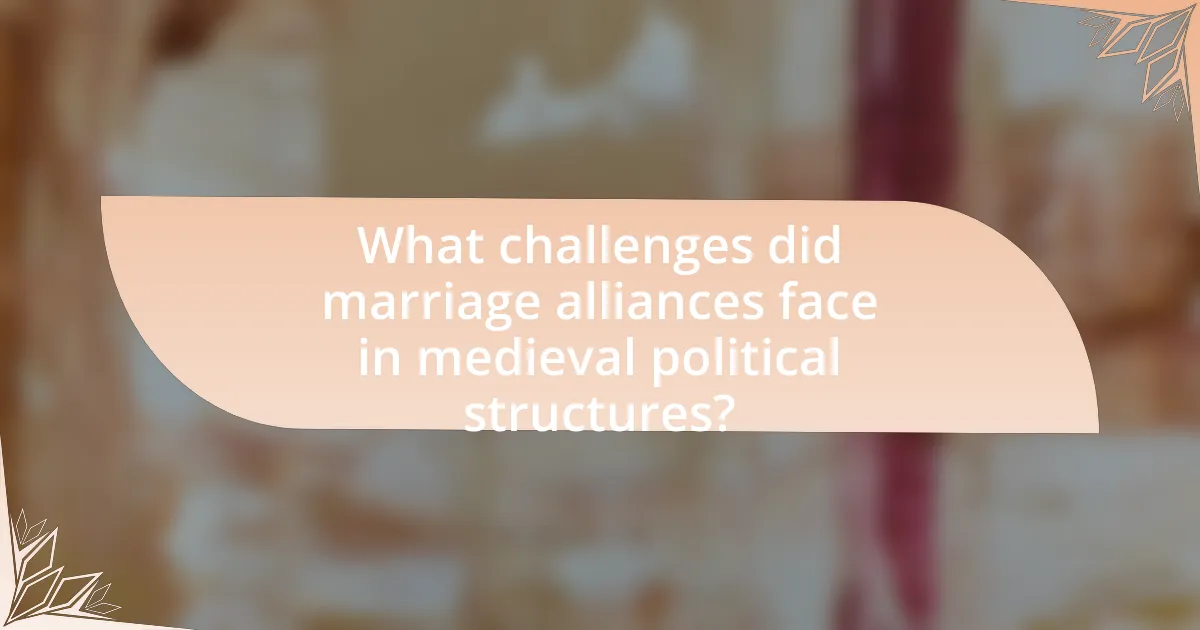Marriage alliances in medieval political structures were strategic unions between noble families designed to consolidate power, secure peace, and enhance political influence. These alliances often involved the marriage of sons or daughters to forge connections that could deter conflicts and expand territorial claims. The article explores how these alliances functioned, their role in consolidating power and influencing territorial expansion, and their significance for political stability and dynastic legitimacy. It also examines the challenges faced by these alliances, including internal conflicts and external pressures, while drawing lessons for contemporary political strategies.

What are Marriage Alliances in Medieval Political Structures?
Marriage alliances in medieval political structures are strategic unions between noble families aimed at consolidating power, securing peace, and enhancing political influence. These alliances often involved the marriage of daughters or sons to forge connections that could deter conflicts, create military partnerships, or expand territorial claims. Historical examples include the marriage of Eleanor of Aquitaine to Henry II of England, which significantly strengthened English claims in France, illustrating how such unions were pivotal in shaping political landscapes during the medieval period.
How did marriage alliances function in medieval politics?
Marriage alliances functioned as strategic tools in medieval politics to consolidate power, secure peace, and enhance territorial claims. Nobles and monarchs arranged marriages to forge alliances between rival factions, thereby reducing the likelihood of conflict and increasing political stability. For instance, the marriage of Eleanor of Aquitaine to Henry II of England in 1152 not only united two powerful territories but also strengthened the English monarchy’s influence in France. Such alliances often included dowries and land grants, further solidifying the political ties between families. Historical records indicate that these unions were crucial in shaping dynastic successions and territorial expansions, as seen in the Habsburgs’ practice of marrying into various European royal families to extend their influence across the continent.
What roles did marriage alliances play in consolidating power?
Marriage alliances played a crucial role in consolidating power by creating strategic partnerships that enhanced political stability and territorial control. These alliances allowed ruling families to secure peace, reduce the likelihood of conflict, and strengthen their claims to power through shared bloodlines. For instance, the marriage between Eleanor of Aquitaine and Henry II of England in 1152 significantly expanded English territories and influence in France, demonstrating how such unions could alter the balance of power in medieval Europe. Additionally, these alliances often facilitated the unification of rival factions, as seen in the marriage of Ferdinand of Aragon and Isabella of Castile, which led to the unification of Spain and the establishment of a powerful monarchy. Thus, marriage alliances were instrumental in shaping political landscapes and consolidating authority during the medieval period.
How did marriage alliances influence territorial expansion?
Marriage alliances significantly influenced territorial expansion by enabling political entities to secure land and power through strategic unions. These alliances often resulted in the consolidation of territories, as seen in the marriage between Ferdinand of Aragon and Isabella of Castile, which unified Spain and facilitated the expansion into the Americas. Such unions allowed for the peaceful acquisition of lands, reducing the need for military conflict and fostering diplomatic relations that could lead to further territorial gains. Historical evidence shows that many royal families used marriage as a tool to enhance their influence and control over regions, thereby directly impacting the geopolitical landscape of the time.
Why were marriage alliances considered essential for political stability?
Marriage alliances were considered essential for political stability because they created bonds between ruling families, thereby consolidating power and reducing the likelihood of conflict. These alliances often resulted in the unification of territories, which strengthened political entities and facilitated peace through shared interests. Historical examples include the marriage of Ferdinand of Aragon and Isabella of Castile in 1469, which united two powerful kingdoms in Spain, leading to a more stable and unified nation. Such unions not only secured alliances but also ensured loyalty among vassals and reduced the risk of civil wars, demonstrating the critical role marriage alliances played in maintaining political order during medieval times.
What impact did marriage alliances have on dynastic legitimacy?
Marriage alliances significantly enhanced dynastic legitimacy by consolidating power and establishing political ties between ruling families. These alliances often provided a sense of stability and continuity, as they linked different noble houses, thereby legitimizing claims to thrones and territories. For instance, the marriage between Eleanor of Aquitaine and Henry II of England in 1152 not only united vast territories but also strengthened the legitimacy of their descendants, who became influential monarchs. Such unions were crucial in reinforcing the authority of rulers, as they were often viewed as divinely sanctioned partnerships that ensured the rightful succession of heirs.
How did marriage alliances help in conflict resolution among noble families?
Marriage alliances helped in conflict resolution among noble families by creating bonds of loyalty and mutual interest that discouraged hostilities. These alliances often resulted in shared resources and military support, which made it less likely for families to engage in warfare against each other. Historical examples include the marriage between Eleanor of Aquitaine and Henry II of England, which united significant territories and reduced conflict between their respective factions. Such unions not only solidified power but also established diplomatic channels for negotiation, further mitigating disputes.

What types of marriage alliances were common in medieval times?
In medieval times, common types of marriage alliances included dynastic marriages, political marriages, and strategic alliances. Dynastic marriages were often arranged to secure succession and strengthen claims to thrones, as seen in the unions of royal families like the Plantagenets and the Capetians. Political marriages aimed to forge alliances between powerful families or kingdoms, exemplified by the marriage of Eleanor of Aquitaine to Henry II of England, which united significant territories. Strategic alliances were formed to enhance military strength or economic ties, such as the marriage between Isabella of Castile and Ferdinand of Aragon, which ultimately led to the unification of Spain. These alliances were crucial in shaping political landscapes and consolidating power during the medieval period.
How did strategic marriages differ from romantic unions?
Strategic marriages were primarily aimed at forming alliances and consolidating power, while romantic unions were based on personal affection and emotional connection. In medieval political structures, strategic marriages often involved negotiations between families to secure political advantages, such as land, resources, or military support, exemplified by the marriage of Eleanor of Aquitaine to Henry II of England, which significantly expanded English territories. In contrast, romantic unions prioritized individual choice and love, often disregarding political implications, as seen in the marriages of commoners or those outside noble circles. Thus, the fundamental difference lies in the motivations behind the unions: strategic marriages served political purposes, whereas romantic unions focused on personal relationships.
What were the motivations behind strategic marriages?
Strategic marriages were primarily motivated by the desire to forge political alliances, consolidate power, and secure territorial claims. These unions allowed noble families to strengthen their influence and ensure loyalty among vassals, as seen in the marriages between royal houses that often resulted in peace treaties or military support. For example, the marriage between Eleanor of Aquitaine and Henry II of England in 1152 significantly expanded English territories and solidified political power in France and England. Additionally, strategic marriages were used to enhance economic ties and improve social standing, as families sought to align themselves with wealthier or more powerful partners to increase their own status and resources.
How did romantic unions affect political alliances?
Romantic unions significantly influenced political alliances by serving as strategic tools for consolidating power and securing peace between rival factions. In medieval times, marriages were often arranged to strengthen ties between kingdoms, as exemplified by the union of Eleanor of Aquitaine and Henry II of England, which united vast territories and resources. Such unions not only facilitated diplomatic relations but also helped to legitimize claims to thrones and territories, as seen in the marriage of Ferdinand of Aragon and Isabella of Castile, which ultimately led to the unification of Spain. These alliances through romantic unions were crucial in shaping the political landscape, as they often determined the balance of power and influenced succession disputes.
What were the key characteristics of successful marriage alliances?
Successful marriage alliances were characterized by strategic political benefits, mutual consent, and the establishment of strong familial ties. These alliances often served to consolidate power, secure peace between rival factions, and enhance social status. Historical examples include the marriage of Eleanor of Aquitaine to Henry II of England, which significantly expanded English territories and influence. Additionally, successful alliances typically involved careful negotiation and the alignment of interests between the families involved, ensuring that both parties gained from the union.
How did social status influence the success of marriage alliances?
Social status significantly influenced the success of marriage alliances by determining the political power, resources, and social connections that each party could bring to the union. High-ranking families often arranged marriages to consolidate power, secure alliances, and enhance their social standing, as seen in the marriages of European royalty where unions were frequently made to strengthen claims to thrones or territories. For example, the marriage between Ferdinand of Aragon and Isabella of Castile in 1469 united two powerful kingdoms, leading to the formation of modern Spain and showcasing how social status directly impacted political stability and influence.
What role did dowries play in the formation of marriage alliances?
Dowries played a crucial role in the formation of marriage alliances by serving as a financial incentive that facilitated the union between families, thereby strengthening political ties. In medieval societies, dowries often included land, money, or valuable goods, which not only enhanced the economic status of the bride’s family but also provided security for the bride within her new household. Historical records indicate that powerful families used dowries strategically to forge alliances, as seen in the marriages of European nobility, where substantial dowries were often a prerequisite for securing advantageous political partnerships. This practice underscored the importance of dowries in solidifying relationships between families and consolidating power within the political landscape of the time.

What challenges did marriage alliances face in medieval political structures?
Marriage alliances in medieval political structures faced significant challenges, primarily due to conflicting interests among noble families. These alliances often aimed to secure peace or strengthen power, but they could lead to disputes over inheritance, loyalty, and territorial claims. For instance, the marriage between Eleanor of Aquitaine and Henry II of England initially united vast territories but later resulted in conflicts over succession and power dynamics within the kingdom. Additionally, the need for political marriages to produce heirs created pressure on families, sometimes leading to the prioritization of political gain over personal relationships, which could destabilize alliances. Historical records indicate that such tensions frequently resulted in civil wars or shifts in allegiances, undermining the intended stability that marriage alliances were supposed to provide.
How did external conflicts impact marriage alliances?
External conflicts significantly influenced marriage alliances by compelling political entities to form strategic unions for mutual defense and stability. During periods of warfare or territorial disputes, rulers often sought marriages to secure alliances that would bolster their military strength and deter aggression from rivals. For instance, the marriage between Eleanor of Aquitaine and Henry II of England in the 12th century was a direct response to the need for consolidating power and resources amidst ongoing conflicts in France. Such alliances not only provided military support but also facilitated peace treaties, as seen in the marriages arranged between warring factions to ensure a cessation of hostilities. Thus, external conflicts acted as a catalyst for the formation of marriage alliances, shaping the political landscape of the medieval period.
What were the consequences of failed marriage alliances?
Failed marriage alliances often resulted in significant political instability and conflict. When alliances were intended to secure peace or strengthen ties between kingdoms, their failure could lead to wars, as seen in the Wars of the Roses in England, where broken alliances among noble families escalated into a series of civil wars. Additionally, failed alliances could weaken a ruler’s legitimacy and authority, as demonstrated by the decline of the Byzantine Empire when strategic marriages failed to secure necessary support from other powers. Furthermore, the loss of potential economic benefits and military support from allied states often followed failed marriages, impacting trade and defense capabilities.
How did changing political landscapes affect existing alliances?
Changing political landscapes significantly altered existing alliances by prompting shifts in power dynamics and necessitating new strategic partnerships. For instance, the rise of centralized monarchies in the late medieval period diminished the influence of feudal lords, leading to the dissolution of traditional alliances based on land and vassalage. This shift compelled noble families to seek marriage alliances with emerging powers to secure their status and influence, as seen in the unions between English and French royal families during the Hundred Years’ War. Such marriages were often used to solidify claims to thrones and territories, demonstrating how political changes directly influenced the formation and reformation of alliances.
What internal factors could disrupt marriage alliances?
Internal factors that could disrupt marriage alliances include familial conflicts, differing political ambitions, and issues of loyalty among family members. Familial conflicts can arise from rivalries or disputes over inheritance, leading to tensions that undermine the alliance. Differing political ambitions may cause one party to prioritize their own interests over the alliance, resulting in a breakdown of cooperation. Issues of loyalty can emerge when family members are torn between their allegiance to their own kin and the obligations of the marriage alliance, creating divisions that weaken the partnership. Historical examples, such as the Wars of the Roses in England, illustrate how internal family disputes can lead to the collapse of marriage alliances and subsequent political instability.
How did personal rivalries influence political marriages?
Personal rivalries significantly influenced political marriages by driving alliances that aimed to consolidate power and mitigate threats. For instance, during the medieval period, rival factions often arranged marriages to strengthen their positions against common enemies, as seen in the unions between the houses of York and Lancaster during the Wars of the Roses. These marriages were strategic, designed to unite factions and reduce hostilities, thereby transforming personal animosities into political leverage. Historical records indicate that such alliances were crucial in shaping the political landscape, as they not only secured loyalty but also facilitated the transfer of resources and military support among rival houses.
What role did succession disputes play in marriage alliances?
Succession disputes significantly influenced marriage alliances by serving as strategic tools for consolidating power and securing claims to thrones. In medieval political structures, noble families often arranged marriages to strengthen their positions in the face of contested successions, thereby ensuring loyalty and support from allied factions. For instance, the marriage between Eleanor of Aquitaine and Henry II of England was partly motivated by the need to stabilize claims to territories amidst succession conflicts in both England and France. Such alliances not only provided legitimacy to heirs but also facilitated military and political support, as seen in the Wars of the Roses, where marriage ties were crucial in determining allegiances among rival factions.
What lessons can be learned from medieval marriage alliances for modern political strategies?
Medieval marriage alliances demonstrate the strategic use of personal relationships to achieve political goals, a lesson applicable to modern political strategies. These alliances were often formed to secure peace, strengthen claims to thrones, or consolidate power among noble families, as seen in the unions between the Houses of Lancaster and York during the Wars of the Roses. In contemporary politics, similar strategies can be observed in coalition-building, where political entities form partnerships to enhance influence and stability. The historical precedent shows that leveraging relationships—whether through diplomacy, alliances, or partnerships—can effectively address conflicts and foster cooperation, underscoring the enduring relevance of strategic alliances in governance today.
How can contemporary leaders apply the principles of marriage alliances today?
Contemporary leaders can apply the principles of marriage alliances today by fostering strategic partnerships that enhance political, economic, and social stability. Just as medieval leaders used marriage alliances to secure power and influence, modern leaders can leverage collaborations with other organizations, nations, or communities to achieve mutual benefits. For instance, international treaties and trade agreements often resemble historical marriage alliances, where parties commit to cooperation for shared prosperity. This approach is supported by historical evidence showing that alliances, whether through marriage or formal agreements, have historically led to increased stability and reduced conflict among nations.
What best practices can be derived from historical marriage alliances?
Best practices derived from historical marriage alliances include strategic selection of partners to enhance political power, fostering diplomatic relations, and ensuring lineage continuity. Historical examples illustrate that royal families often arranged marriages to solidify alliances; for instance, the marriage between Ferdinand of Aragon and Isabella of Castile in 1469 united two powerful kingdoms, leading to the unification of Spain. Additionally, these alliances often involved careful consideration of cultural and religious compatibility to minimize conflict, as seen in the marriages between European monarchs and their counterparts in other regions. Such practices demonstrate the effectiveness of marriage alliances in achieving political stability and territorial expansion.